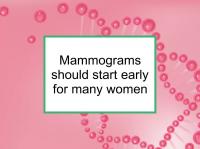In April 2024, the U.S. Preventive Services Task Force issued a finalized recommendation that women should begin mammograms at age 40 (first issued as a draft in May 2023). This was a major change to its previous recommendation that women under 50 should not have routine screening mammograms unless in a high-risk category.
Factors linked to increased risk of breast cancer
All women with a first degree relative with breast cancer are at increased risk compared to the general population, not just those with family members who have harmful BRCA1 or BRCA2 mutations. In addition, women with a history of benign fibrocystic breast disease, previous breast biopsy, and use of hormone replacement therapy (HRT) (for example, after early hysterectomy) are at increased risk of breast cancer.
There are also some factors relating to prenatal, childhood and adolescent exposures that influence breast cancer risk later in adulthood. For example, high birth weight (and long length at birth) has been linked to increased risk (see our article on the prenatal period and infancy for more information). Early age at menarche (first period), which increases premenopausal cumulative estrogen exposure, also appears to increase subsequent breast cancer risk (see childhood and puberty). Use of tobacco, alcohol or birth control pills starting during the teenage years also disproportionately increases breast cancer risk compared to later use (see teenage years and young adulthood).
In addition, certain occupations have been linked to increased breast cancer risk. These include those with significant exposures to night shift work, ionizing radiation, petroleum-based chemicals such as organic solvents, car and truck exhaust, dyes and inks, pesticides and herbicides. It is difficult to quantify the degree of additional risk conferred by such exposures, however it can be meaningful.
Unfortunately, most cases of breast cancer among women in their 40s are found in those not in a traditional high risk group. For example, one study of women aged 40 to 49 (who were screened with mammograms and found to have breast cancer) reported that invasive breast cancer was diagnosed with equal frequency in women presenting with or without a family history.
Women with dense breasts are more likely to develop breast cancer than those whose breasts consist almost entirely of fat. However, a woman's degree of mammographic density will not be measured until her first mammogram.
Women of color are at higher risk of aggressive BC at young age
White women of predominantly European background are more likely to develop breast cancer during their lifetimes than African Americans, Latinas and some Asian American groups. However, when African-American women do develop breast cancer, they tend to be younger (57 year median age at diagnosis compared to 62 to 64 years for whites) and are more likely to have aggressive disease such as triple negative (ER-/PR-/HER2-) or inflammatory breast cancer (IBC). Latinas, as well as women with Indian and Pakistani heritage living in the U.S., are also more likely to be younger at diagnosis (54 to 55 years) and to be diagnosed with triple negative disease. This suggests that starting mammograms at age 40 may be particularly important for many non-white women even if they have no other obvious risk factors.
Overdiagnosis is not solved by restricting the use of mammograms
The latest U.S. Preventive Services Task Force recommendation also states that screening take place every other year through age 74. The underlying problem contributing to overdiagnosis is not that women are having unnecessary mammograms but rather that mammograms need to improve. False positives, false negatives, and problems evaluating mammograms of women with dense breasts are all emblematic of difficulties with regard to mammogram accuracy. More precise screening mammograms and other forms of breast cancer screening are needed.
Below are links to 20 studies concerning this topic. For a more complete list of studies, please click on mammogram.
